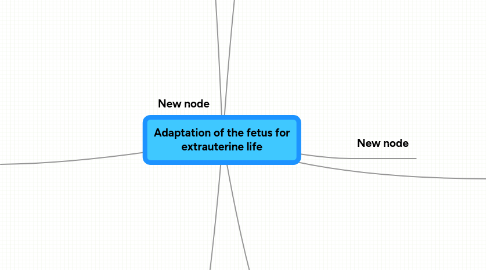
1. Respiration- the lungs
1.1. Fetus
1.1.1. Lungs are filled with fluid secreted by lungs: this exchanges with amniotic fluid
1.1.2. Fetal Breathing Movements are observed from the first trimester becoming more regular with gestation
1.1.2.1. Suggested that this promotes development of the respiratory muscles
1.2. Neonate
1.2.1. Factors that stimulate first breath: temperature change, clamping of the cord ^ventilatory drive, compression of vaginal delivery
1.2.1.1. First breath- diaphragm contracts strongly
1.2.1.1.1. Fluid is quickly reabsorbed
2. Temperature regulation
2.1. In utero- dependant on mother
2.2. In the neonate
2.2.1. Temperature loss after birth due to change in environment
2.2.1.1. Neonate has less subcutaneous fat, and higher surface: mass ratio than adults do
2.2.2. Mechanisms for losing heat is not well developed
2.2.2.1. Can lose small amount through sweat, but mainly by peripheral vasodilatation
3. Liver
3.1. Immature function
3.1.1. Glucose regulation
3.1.1.1. Glucose levels fall after delivery
3.1.1.1.1. Immature liver is better at glycogen synthesis than glycogenolysis
3.1.2. Fuel storage
3.1.2.1. In fetus
3.1.2.1.1. Glycogen is stored in skeletal muscle
3.1.2.2. In neonate
3.1.2.2.1. Neonate uses ketone bodies for energy production until enough milk is consumedmto maintain
3.1.3. Billirubin
3.1.3.1. Inefficient ability to synthesise plasma proteins and metabolise foreign substances
3.1.3.2. In fetus removed by placenta
3.1.3.3. In neonate decreased production of plasma proteins can result in a build up of unconjugated billirubin
3.1.3.3.1. Liver deconjugates billirubin to water soluble enabling secretion
4. Gastrointestinal system
4.1. Neonate has immature digestive tract and absorptive capacities
4.1.1. Hormone and enzyme production
4.1.1.1. Developed but low
4.1.1.2. Decreased acidity and protein digestion may enhance the defence mechanism, promoting the activity of immunoglobulins
4.1.1.3. Pancreatic amylase is low however, breast milk contains mammary amylase which can augment starch digestion
4.1.1.4. Bile acid formation is low however, human breast milk is rich in taurine, enabling neonatal conjugation of bile salts
4.2. Feeding reflex= can suckle from birth
5. Kidneys
5.1. In utero
5.1.1. Placenta maintains osmotic pressure
5.2. In the neonate
5.2.1. Immature renal function
5.2.1.1. Can prevent dehydration and eliminate lower level metabolic waste products of breast feeding infant
5.2.1.2. Low glomerular filtration rate
5.2.1.3. Half life of drugs are increased as slow elimination by renal system
6. Bowel movement
6.1. Meconuim- mucous, epithelial cells, fatty acids and bile pigments
6.2. First bowel movement within 24hours.
6.2.1. Stool slowly combines with metabolic waste and eliminates all meconium
